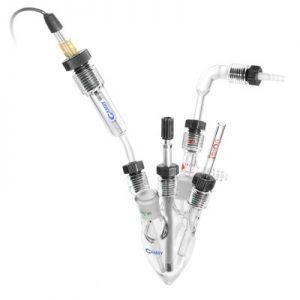An electrochemical cell consists of two half-cells. Each half-cell consists of an electrode in contact with an electrolyte.
- An electrode is an electronic conductor such as metal or carbon or a semiconductor. Current flows through the electrodes via the movement of electrons.
- An electrolyte is a phase in which charge is carried by ions.
In a full electrochemical cell, species from one half-cell loses electrons (oxidation) while species from the other half-cell gain electrons (reduction). Remember, LEO (Lose Electrons Oxidation) the Lion says GER (Gain Electrons Reduction).
Electrochemical cells are usually classified as either galvanic or electrolytic. In galvanic cells, reactions occur spontaneously at the electrode–electrolyte interfaces when the two electrodes are connected by a conductor such as a metal wire. Galvanic cells convert chemical energy to electric energy and are the components of batteries, which usually contain several cells connected in series.
In electrolytic cells, reactions are forced to occur at the electrode–electrolyte interfaces by way of an external source of power connected to both electrodes. Electric energy from the external source is converted to chemical energy in the form of the products of the electrode reactions.
If an electric current is produced by a spontaneous chemical reaction as in a battery, it is called an electrochemical reaction. Chemical reactions where electrons are transferred directly between molecules and/or atoms are called oxidation-reduction or (redox) reactions. Electrochemistry describes the overall reactions when individual redox reactions are separate but connected by an external electric circuit and an intervening electrolyte.
Electrode Potentials
Current and potential (or voltage ) are the two electrical variables of greatest interest in electrochemical cells. Current is related to the rate of the electrode reactions, and the potential, to the cell energetics.
Electrochemical Impedance
Electrochemical impedance is usually measured by applying an AC potential to an electrochemical cell and then measuring the current through the cell. Assume that we apply a sinusoidal potential excitation. The response to this potential is an AC current signal.
*See Gamry’s Application Note “Basics of Electrochemical Impedance Spectroscopy“.

